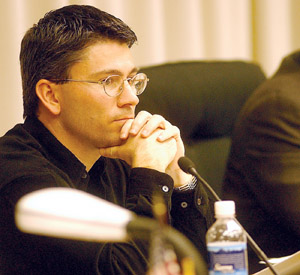
City Councilwoman Pauline Valdivia called it a window of
opportunity. Mayor Tony Bruscia worries it could create a false
hope.
Those sentiments were offered by the city leaders Tuesday about
the next two weeks before a pushed off Council vote Jan. 28 on
Hollister’s proposed layoff plan.
City Councilwoman Pauline Valdivia called it a window of opportunity. Mayor Tony Bruscia worries it could create a false hope.
Those sentiments were offered by the city leaders Tuesday about the next two weeks before a pushed off Council vote Jan. 28 on Hollister’s proposed layoff plan.
The Council delayed an approval Monday – allowing more time for union leaders to meet with city management, and for Council members to grasp potential effects of the cuts.
There are mixed feelings among Council members and officials whether two weeks will make a difference – whether the proposed 36 layoffs could diminish or even change at all.
“I’m afraid that our financial situation is not getting better,” Bruscia said Tuesday. “It’s getting worse, and I don’t want to give people a false hope.”
Councilman Robert Scattini on Tuesday agreed with Valdivia. He believes there’s a “real hope,” he said, that the size of the layoff proposal can be reduced by Jan. 28.
“I think Dale put a lot of work in, and I think Dale’s doing an outstanding job,” Scattini said. “It’s just I feel, two more weeks – maybe it will make a difference. And maybe it won’t.”
Shaddox completed the “Reduction in Force” plan last week with guidance from a Council subcommittee made up of Bruscia and Councilman Brian Conroy. Hollister is trying to fill a $1.8 million gap in next fiscal year’s budget.
Thirty-six layoffs would accomplish that, according to Shaddox, while cutting 21 percent of the workforce.
As of Tuesday, no talks had been scheduled between City Manager Dale Shaddox and union head John Vellardita of Service Employees International Union (SEIU), according to Vellardita. Shaddox on Tuesday did not immediately return phone calls made to his office.
Vellardita said he applauded the Council’s delay. SEIU, which represents about 70 city workers, is ready to meet “as often as we can” to discuss other ways to cut spending, he said.
He said he hopes to find a “balanced approach to these fiscal problems.”
Other employee groups that may seek changes to the proposal are those representing the Police Department, mid-management and executive management employees.
“If there’s a real, sincere effort to be open-minded,” Vellardita said, “I think there can be an impact (on the number of layoffs).
“Can it be a great impact in two weeks? I don’t think that’s enough time to develop a significant impact. But in time, we can try to agree on cost savings.”
The layoff list includes department heads, too, as the plan focused on first examining management positions for potential cuts. Among the proposed layoffs are the fire chief, planning director and finance director positions – all their salaries can reach six figures.
Fire Chief Bill Garringer’s position was a hot topic Monday night – as several residents and employees denounced its vacancy.
It remained so Tuesday. Valdivia and Scattini both expressed skepticism on functioning without a chief.
“We need a leader,” Scattini said. “I think it would be a blow to the whole department.”
Before Shaddox finalized the plan Jan. 9, he offered to take suggestions from city employees. On Monday he included those, along with his response to each, in a handout to Council members.
Some ideas, he said, were under consideration for the 2004-05 fiscal year. But none would help enough to alleviate future projected financial problems, according to Shaddox.
Even with layoffs, Hollister’s General Fund reserve will be gone by 2008, he expects. Without layoffs, the city would be $10 million in debt in four or five years.
Danny Hillstock, a city engineer and president of the local SEIU, said employees are willing to accept pay cuts or whatever it takes to lessen the severity of layoffs.
“There are things out there that can reduce the effect of the layoffs being proposed by the city,” said Hillstock, whose wife, a City Hall administrative assistant, made the list – while his position did not.
Vellardita referred to the city manager’s financial projections as “skewed numbers.” He said the estimates assume there will be no economic growth or enhanced revenues in California.
Bruscia disagreed, though, and remained convinced the numbers could worsen yet. Since the Council received the “five-year trend analysis” Monday, he said the delayed vote allows all Council members an opportunity to realize how gloomy the future could be.
As far as the Jan. 28 meeting goes, Hillstock said he expects a similar attendance as the nearly 150 people at City Hall on Monday.
Regarding the pressures of Monday’s study session, Scattini said, “If there was a trap door in the floor, I think I would have crawled through it.”








